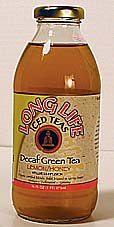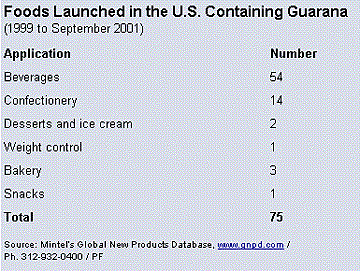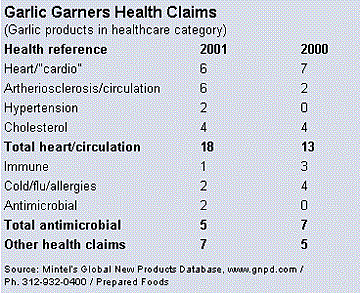
For example, the January 2001 FDA “Letter to Manufacturers Regarding Botanicals and Other Novel Ingredients in Conventional Foods” discussed the use of non-GRAS ingredients in foods. The letter cooled the growing food use of components with non-GRAS status.
However, the botanical category is broad and contains an eclectic array of products. Some botanicals are clearly pharmaceutical alternatives, some have an ambiguous regulatory status, and some are foods themselves.
Introduced in 2001, GlaxoSmithKline's, Pittsburgh, Penn., Remifemin Menopause, a hormonal replacement therapy alternative, falls into the first category. The product is standardized to 20mg black cohosh extract (a native North American plant, Cimicifuga racemosa). On the other end, rosemary and garlic are used as a food antioxidant and studied as a potential food antimicrobial, respectively, but also are key components in supplements.
Here is a brief overview of five products. A few products cannot represent the botanical category. However, they provide a flavor of trends in this area.
Garlic and Saw Palmetto
A search for garlic-containing products on Mintel's Global New Products Database (GNPD) results in “a cast of thousands,” due to its popularity as a seasoning. When the search is limited to products in the healthcare category, 79 items appear as newly-introduced—globally—in 2000 and 2001. A closer look at these products shows 55 health references were made. Heart and circulation-type claims were most popular, followed by garlic's antimicrobial properties, which extend to its ability to reduce cold and allergy symptoms. For example, Roche Consumer Health, New York, N.Y., developed Avon's VitAdvance branded Heart Health Formula E Dietary Supplement, which contains garlic to help retain normal blood cholesterol levels.
Past promotional claims attached to garlic range from benefits for skin, gall bladder and joint health, to the ability to combat worms, (in pets, one assumes).

Products introduced before 2001 tend to emphasize saw palmetto's benefit in BPH. However, over the last few years, there has been an increase in claims addressing a variety of men's concerns. The slide away from science and BPH toward generalized claims for men results in a confused message that “saw palmetto has something to do with hair.” That is, three hair care products containing this botanical were introduced in the above period. Two made claims in regards to restoring hair and one for hair removal—Del Labs', Farmingdale, N.Y., Sally Hansen brand Gentle Formula Lotion Hair Remover.
Three Gs
Mintel's U.S. Ingredients Report looked at the use of guarana, ginseng and gingko biloba in foods. Ginseng was found in 140 of the 232 products introduced in 2000 that contained at least one of these herbs, and 57 of the 130 products introduced during the first nine months in 2001.The report notes that most of the action in herbal fortification in the U.S. has been in beverages, where “the youth-oriented 'energy' drinks in slim and trendy cans sold single-serve in convenience stores have achieved fast growth.” Confectionery, then snacks (e.g., energy bars) and spreads, were the next most popular applications for fortification with these herbs.
Companies in the rest of the world have similar applications for these herbals. For example, virtually all guarana use occurs in the beverage, confectionery or dietary supplement categories.
Guarana (Paullinia Cupana) seed powder contains guaranine, a stimulant similar to caffeine. Guarana products are touted for their ability to reduce tiredness, increase energy and attention span, or assist with weight loss. It is a key ingredient in the popular Brazilian soft drink 'Guarana Antarctica' soda, introduced in Portugal in 2001. (PepsiCo holds Guarana Antarctica's worldwide marketing rights.)
In another example, Energy Ice, a “popsicle” made with guarana and ginseng, was launched by Nestlé - Dairymaid (South Africa) last year.

Although the “next hot botanical” will—most likely—show up in dietary supplements, food products are not necessarily left out of the excitement. For example, much attention lately has been given to the health properties of one manufactured product derived from Theobroma cacao—chocolate. Endangered Species Chocolate's, Talent, Ore., promotional literature for Taste Therapy Truffle chocolate bars refers to antioxidant health benefits.
Such claims may cloud issues in regards to the benefits of botanicals but, also, serve as a reminder that plants may provide health in unexpected ways.
A thank-you goes to Mintel Consumer Intelligence: U.S. Ingredients Report, which provided some information for this article: 312-943-5250; www.consumer.mintel.com
Sidebar: Great Expectations
In mainstream foods and beverages, manufactures will take a more conservative approach and require documentation on safety, efficacy, chain of supply, etc.Food and beverage will drive use of 15 or 20 botanicals with squeaky-clean reputations. Examples include: ginger, garlic, saw palmetto, valerian, chamomile, guarana, yerba mate, tumeric, rosemary, green tea.
— Brian Keating, Sage Group Ltd., sagebk@aol.com
Doctors and pharmacists, using a “Western” scientific viewpoint, are actively learning about and evaluating botanicals, which will likely increase their use.
Plants that are popular with certain ethnic populations, (i.e., Noni among Latinos) will experience growth spurts.
Many “up-and-coming” botanicals will have a dual food-supplement background, such as nopal, fenugreek, and perhaps maca.
Botanicals that provide a thermogenic action, are an ephedra alternative, or that assist with weigh loss will be hot.
— Kerry Hughes, Ethnopharm, kerry@ethnopharm.com